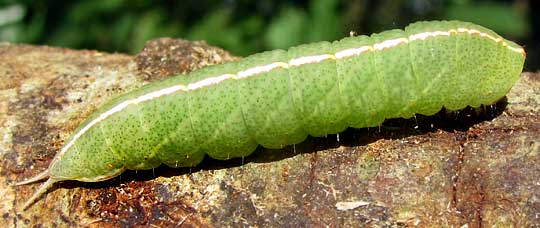Excerpts from Jim Conrad's
Naturalist Newsletter
from the November 1, 2009 Newsletter, from near Natchez, Mississippi
A PROMINENT CATERPILLAR

While I chainsawed firewood the caterpillar shown above turned up on a fallen oak limb. I sent the picture to Bea in Ontario who quickly replied that it might be the Mottled Prominent, MACRUROCAMPA MARTHESIA, and after my own Googling I'm thinking she's right.
I knew that Bea didn't have a caterpillar field guide so I asked her how she came up with the ID so fast. Her reply describes a search-engine procedure that might be useful to anyone with an unknown organism and an Internet connection:
I usually look for something on our specimen that would set them apart from other insects of their type. After a simple search for "green caterpillar" "white stripe" yielded way too many images and after searching the first ten or so of those pages without getting close I decided to try and find out the name of those things that were sticking out his rear end. After finding out they were called "anal prolegs" and the caterpillar in our picture had "long anal prolegs" I did a search on "long anal prolegs" caterpillar ... and after searching those images I came across a caterpillar called Prominent, but it didn't look at all like your picture except for the long anal prolegs so then I searched on Prominent and eventually came across one that looked like yours.
Once you have an organism's name you can search on the name to find interesting stuff about it. A quick search on "Macrurocampa marthesia" turned up a picture of the adult moth the caterpillar eventually metamorphoses into, after passing through its pupa stage, as well as its distribution map. That's at https://www.butterfliesandmoths.org/species/Macrurocampa-marthesia.
Apparently there's not much more known about this particular species, but the same site gives an overview of the species' family, the Notodontidae. There I learn that when resting the moths hold their bodies in a way causes them to look like a stick. Most prominents overwinter as larvae, pupating in cell in the soil or in loose cocoons on the ground. My caterpillar was big enough to have been looking for a spot to metamorphose into an overwintering pupa.